Source: Hardware Why, Thank You!
The allure of the 5G era is like the aroma from a neighbor’s kitchen, intermittently wafting over and stimulating everyone’s nerves. However, for the industry, the signal of this aroma is too weak. Before 2020, there was little hope for the large-scale application of 5G; no equipment manufacturers believed that 5G could be rapidly deployed. Even though the relevant standards are progressing rapidly, the freeze period for the standards from June to September has just begun, and there is still a long way to go before establishing base stations and compatibility mechanisms (future Huawei and ZTE must be mutually compatible).
Industrial IoT, being a regional network, has the potential for breakthroughs. However, during the 4G era, everyone was driven crazy by Qualcomm’s chips and standards, and finally found a scapegoat in the industrial sector. There are ways to bypass Qualcomm without having to wait for the 5G era, with NB-IoT narrowband IoT taking the lead.
Three Brothers of the 5G Era
5G has three standards: LTE (Licensed Channel), LTE-U (Unlicensed Channel), and NB-IoT (Licensed Channel).

What is LTE
LTE belongs to the licensed channel. This is the biggest piece of cake, of course, for telecom operators. The standards are mainly developed by telecom operators, and Huawei is also promoting it. Since the licensed channel is essentially exclusive, for example, if it is allocated to power microwaves, others cannot use it. This is a monopoly resource for operators and can only be operated through them.
We often hear the term “5G,” which stands for “5th generation mobile networks,” but it is not a product that is completely separated from 4G or even earlier versions of communication technology; rather, it indicates that mobile communication technology is about to undergo a performance leap that can be summarized as a “generational change.”
So what does LTE-A mean? Its full name is “Long Term Evolution Advanced,” which is essentially an upgraded version of the communication standard that transitions from 3G to 4G LTE. Compared to previous LTE technology, LTE-A has developed a series of more advanced communication technologies such as unlicensed judgment, carrier aggregation, and high-order MIMO, which can provide users with a better mobile communication experience.
For example, the LTE technology we use in 4G is closely related to several technologies from the 3G era: HSPA, WCDMA, CDMA-2000, TD-SCDMA. The same goes for LTE-A and 5G; more accurately, LTE-A will actually become a part of 5G.
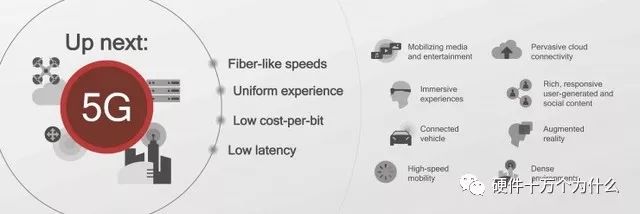
As a sign that mobile communication technology is about to enter the next phase, the core changes in 5G are three points: faster speeds, the ability to accommodate more users simultaneously, and lower network latency.
This sounds like a cliché, but if viewed from the perspective of application scenarios, you might better understand the importance of 5G. It is no longer limited to traditional mobile communication devices like mobile phones and tablets; it is set to penetrate into IoT and various industry fields, effectively meeting the business needs of vertical industries such as industrial, medical, and transportation, achieving true “Internet of Everything.”
In summary, the network that future users will experience will no longer differentiate between wired and wireless; 5G is the network, and the network is 5G.
Therefore, from the perspective of the impact of mobile communication on the economy and society, 5G is expected to make mobile communication technology a new “general-purpose basic technology.”
The LTE-A that continues to “shine” behind 5G
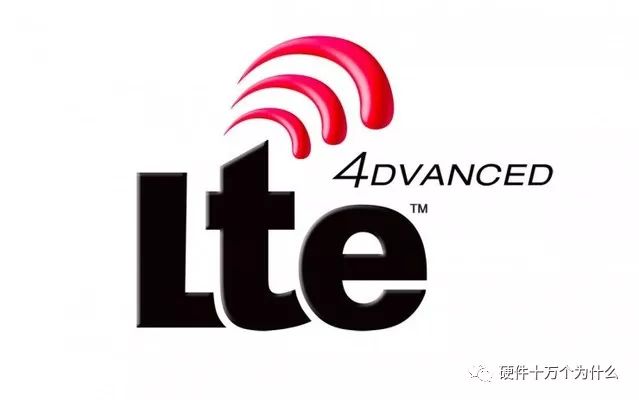
To become a new “general-purpose basic technology,” 5G itself also needs to undergo significant changes, one of which is the new radio technology for 5G. The core component of the latter is a new wireless standard based on Orthogonal Frequency Division Multiplexing (OFDM) that can communicate using radio frequencies from 1GHz to 100GHz. In comparison, the current LTE/LTE-A technology uses a communication radio frequency range of 1GHz to 6GHz.
The difference in the radio frequency range is directly related to the application scenario settings. By adding new millimeter-wave frequency ranges of 6GHz to 100GHz, 5G can achieve higher theoretical transmission speeds, while having a wider communication bandwidth and, consequently, a larger user capacity.
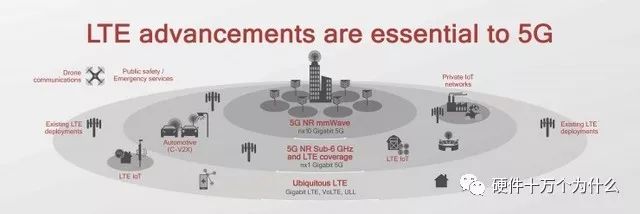
LTE-A is “critical” for the 5G era
But this change also comes with a “cost”: even with new technologies like Massive MIMO to improve frequency band efficiency, the coverage range of the newly added millimeter-wave bands is extremely limited. According to some academic studies, its coverage radius can only reach about 200m, while the coverage radius of the currently used 4G at 2.6GHz can actually reach about 2000m. This means that if we really want to fully cover the future 5G network with millimeter-wave bands, the number of base stations required will reach an astonishing 100 times.
Therefore, in the planning of 3GPP R15, four methods for 5G networking were proposed, three of which will play important roles with LTE base stations. More importantly, LTE will not stop progressing with the arrival of 5G; its own “upgrading” is also ongoing.
Qualcomm Snapdragon X20 Modem, LTE Upgraded

So in which direction should LTE, as the backbone technology of 4G, upgrade? Recently, Qualcomm provided its answer at its annual Snapdragon Technology Summit: speed. This is particularly evident in the next-generation mobile platform Snapdragon 845, which features Qualcomm’s latest generation commercial modem – Snapdragon X20 Modem.
Snapdragon X20 Modem is actually Qualcomm’s second-generation gigabit LTE modem, and the company stated that it is “the LTE modem supporting the most advanced combination of wireless features to date.”
Although it is based on existing LTE technology and frequency bands, Snapdragon X20 Modem can already stably maintain a download speed of 1.2Gbps.

Because Snapdragon X20 Modem can support up to five carriers and achieve 12-channel simultaneous operation with the help of 4×4 MIMO technology, it can realize LTE Category 18 download speeds. Additionally, due to the flexible combination of new spectrum usage, Snapdragon X20 Modem only needs a 10MHz licensed spectrum to achieve gigabit-level LTE, significantly lowering the threshold for operators.
At this Snapdragon Technology Summit, Qualcomm’s technical personnel stated to Lei Feng Network: “Since most of the technology is still based on existing LTE technology, 27 countries with 45 operators have already or will soon upgrade their LTE networks to support the new speed of LTE.”
From LTE to 5G and into the future, Qualcomm’s presence is everywhere.
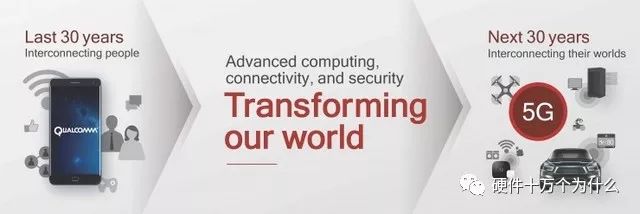
The progress of LTE technology is also paving the way for the advancement of communication technology in the future 5G era. Taking Snapdragon X20, which achieves a download speed of 1.2Gbps, as an example, its new five-carrier, 12-channel flexible working mode can also be applied to 5G modems in the future.
What is LTE-U
LTE-U (Unlicensed) is the unlicensed channel, and it is known as the WiFi killer. WiFi routers typically have a range of only 30-50 meters; generally, when a router reaches 100 meters, it only has a signal and cannot communicate. In contrast, LTE-U can reach 300-500 meters (similar to the “metropolitan area network” promoted during the 3G era). The ISM (Industrial, Scientific, Medical) bands can be freely used, mainly covering multiple bands from 5K, 13.56M to 2.4G and 5.8G.
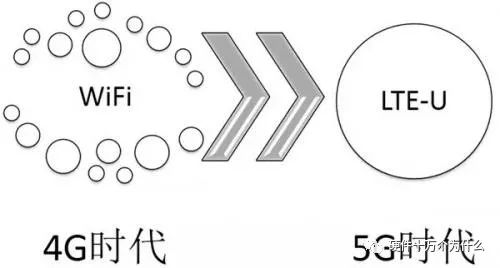
Why is LTE-U needed?
The standard LTE technology can only be deployed on licensed spectrums and cannot be directly deployed on unlicensed spectrums. As LTE technology and applications gradually mature, the data traffic in licensed spectrums is becoming increasingly saturated, making it necessary to consider offloading some traffic from licensed spectrums to unlicensed spectrums. Through the joint efforts of operators, equipment manufacturers, and chip manufacturers, the mainstream technologies currently available for offloading LTE traffic to unlicensed spectrums are: LTE-U, LAA (Licensed Assisted Access), LWA, and MulteFire.
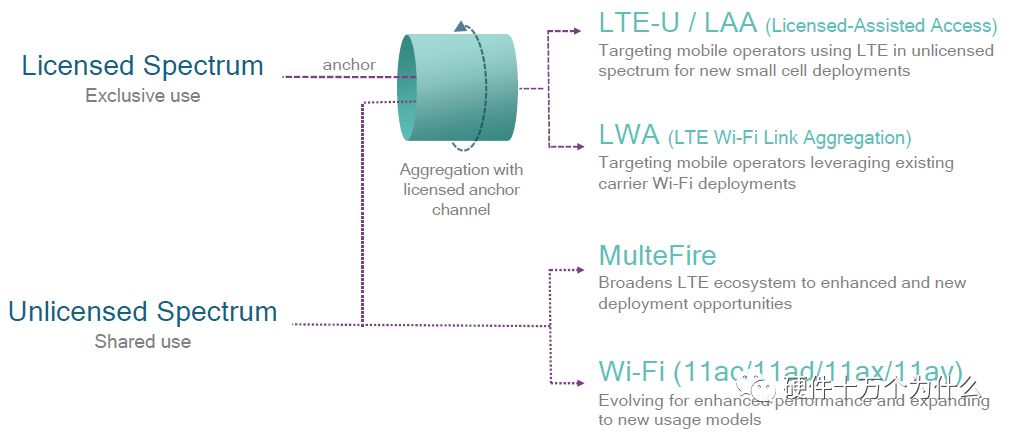
Figure: Mainstream technologies for aggregating licensed and unlicensed spectrums
2 Advantages of LTE-U
The first developed technology is LTE-U, which stands for LTE in Unlicensed spectrum. This technology deploys LTE on unlicensed spectrums and uses standard LTE air interface protocols to complete communication.
By adopting LTE-U technology, better robustness and spectral efficiency can be achieved through centralized scheduling, interference coordination, HARQ retransmission, and CA carrier aggregation, providing greater coverage and better user experience. LTE-U can use the licensed band as the primary carrier, and terminals can establish radio resource control connections on the licensed band, using carrier sensing to access currently available unlicensed band resources, thus achieving carrier aggregation between licensed and unlicensed bands, effectively improving system performance and throughput to meet the growing demand for indoor data traffic and the problem of spectrum scarcity.
The difference between LTE-U and LTE/LTE-A is merely the working frequency bands; existing LTE deployments can be utilized without needing to change the network structure, only requiring upgrades to base stations, significantly reducing investment costs for operators. For operators, deploying LTE on unlicensed spectrums allows them to increase network capacity without spending billions of dollars bidding for licensed spectrums. Additionally, the increase in capacity and smoother management, providing better experiences for users, can also bring economic benefits to operators by increasing service revenue and reducing customer churn.
3 Coexistence of LTE-U and WiFi
In public networks, LTE-U is mainly applied in the 2.4GHz and 5GHz bands, operating in the same frequencies as existing WiFi networks.
Due to some countries’ regulatory authorities requiring LTE-U technology to include a feature to prevent excessive interference with WiFi, known as LBT (Listen Before Talk), while LTE-U itself does not need to implement LBT technology, it has thus developed in countries like the USA and China, where regulatory authorities do not enforce LBT.
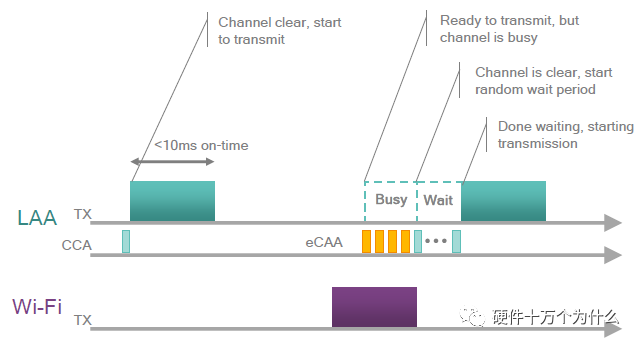
Figure: LAA-supported LBT technology
For operators and manufacturers involved in LTE discussions, the main challenge is proving that LTE-U can coexist with WiFi on unlicensed spectrums. WiFi will assess channel activity before starting transmission and will automatically back off if it finds the channel occupied, which is the essence of Listen Before Talk (LBT), but LTE-U does not support LBT.
LTE-U uses a method known as Carrier Sensing Adaptive Transmission (CSAT), which is a form of channel time-sharing. Since CSAT does not listen to the channel before transmission, it may interfere with WiFi transmissions.

Figure: CAST technology adopted by LTE-U
4 Development of LTE-U
The LTE-U proposal was officially made in 2013, and in 2014, Verizon, along with Alcatel-Lucent, Ericsson, Qualcomm, and Samsung, established the LTE-U Forum to jointly develop related technical documents based on the 3GPP R12 protocol. This means that LTE-U technology was not developed and evolved by the 3GPP organization, which is a significant disadvantage compared to LAA.
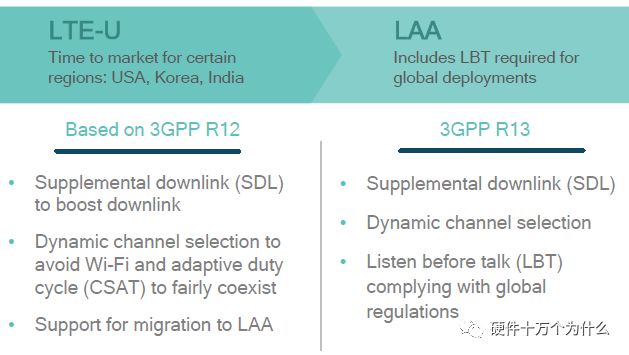
Figure: Differences between LTE-U and LAA
Although operators like Verizon have a positive attitude towards LTE-U, many concerns and doubts remain among WiFi technology providers that use unlicensed spectrums regarding whether they can coexist with the LTE-U protocol. WiFi technology is a significant user of unlicensed spectrums, and WiFi providers worry that LTE will not adopt the LBT protocol used by WiFi to avoid interference.
In 2015, Ericsson and Qualcomm collaborated to demonstrate LTE-U technology, combining a 20MHz licensed frequency unit with a 20MHz unlicensed frequency unit in the 5GHz band, achieving a peak download speed of 300Mbps over the air interface.
What is NB-IoT
NB-IoT, or Narrow Band Internet of Things, is a cellular network connection technology specifically designed for the Internet of Everything. As the name suggests, NB-IoT occupies a narrow bandwidth of about 180KHz, and it uses licensed frequency bands, which can be deployed in-band, guard band, or as a standalone carrier, coexisting with existing networks, and can be directly deployed on GSM, UMTS, or LTE networks (2G/3G/4G), reusing existing networks, reducing deployment costs, and achieving smooth upgrades.
Mobile networks, being the largest globally, have unique access capabilities, thus compared to WiFi, Bluetooth, ZigBee, and other wireless connection methods, the NB-IoT connection technology based on cellular networks is more promising and is gradually being commercialized in the IoT industry as the key to unlocking the era of the Internet of Everything.
Currently, the most sought-after NB-IoT still belongs to the licensed channel. The biggest feature of NB-IoT is its transmission distance, reaching an astonishing 10km, which can cover a small county. Moreover, it can connect countless terminals, with a single base station capable of connecting over 200,000 terminals. This implies that managing a manhole cover or parking fees has become easy and cheap. Even if it costs 2 million yuan to establish a base station, it can manage an area of 10km.
Of course, since NB-IoT belongs to the licensed channel, it is still unlikely to be used in enterprises. Therefore, NB-IoT can only first connect to the core network (operator) before entering enterprises.
5G Can Solve Industrial Ethernet
Compared to general Ethernet, the real-time requirements for industrial data transmission are very high. Industrial Ethernet has QoS (Quality of Service protocols), which makes it less likely to lose packets when transmitting real-time data. This is because QoS supports prioritization, enabling the identification of priority sending levels, such as automatically recognizing voice over email. Voice has a high real-time requirement, and packet loss would cause noise; while video packet loss would result in garbled images. These are unacceptable. Real-time video must have QoS, and images are often the content that consumes the most bandwidth.
4G cannot be used in industrial internet because it lacks QoS; apart from voice recognition, it can be considered a standard IT network. However, 5G can support prioritization, for example, giving priority to device status while placing general data transmission at the end.
Therefore, it is worth looking forward to 5G being the foundation of the industrial internet. Currently, 40% of situations are basically implementable (saying 100% is a bit exaggerated). 4G can reach a maximum of 450M, while 5G’s LTE can reach 450M to 800M.
More importantly, the choice is greatly increased. From a technical standpoint, the 4G era was mainly dominated by Qualcomm, who profited immensely; while in the 5G era, Huawei, Cisco, Siemens, and others all have their own technologies. This time, the industry can have more choices.
Technology Cannot Sit Idle
LTE is an operator standard and cannot be allowed to enter enterprises, so it is impossible to establish a base station like an iPhone 7. However, since the 5G standard and large-scale deployment are still pending, these emerging technologies cannot be idle. Hence, technology begins to transform and evolve, for instance, LTE has an improved version, and Huawei has taken the lead in launching the so-called enterprise LTE technology (eLTE).
It has two frequency bands, one is 800M (currently allocated to Unicom), and the other is 900, which is frequency modulated. This band can be used to complete the carrier frequency point of eLTE, which can be used for enterprise applications.
Based on the same considerations, eLTE-IoT is precisely a workaround for NB-IoT narrowband IoT. This way, it can enter factories and become the cornerstone of IoT in intelligent manufacturing. Importantly, eLTE-IoT has a much lower cost, thus eLTE-IoT is the first to enter the industrial sector.
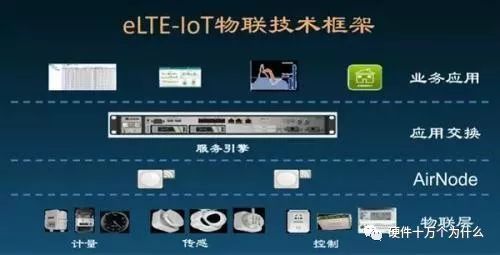
eLTE-IoT itself has outstanding features (low power consumption, many terminals, long distance), thus becoming one of the best vanguards of 5G in industrial parks. As an unlicensed channel, eLTE-IoT has a bandwidth of 200,000, and its power is very low, not exceeding 200mw. Therefore, establishing such base stations in parks does not interfere with each other.
Currently, eLTE-IoT has begun to gradually enter factories, becoming the best means for IoT data transmission. It will effectively replace RFID, equipment networking, and other fields, becoming the new favorite of intelligent factories in the IoT.
Development History of NB-IoT Technology:
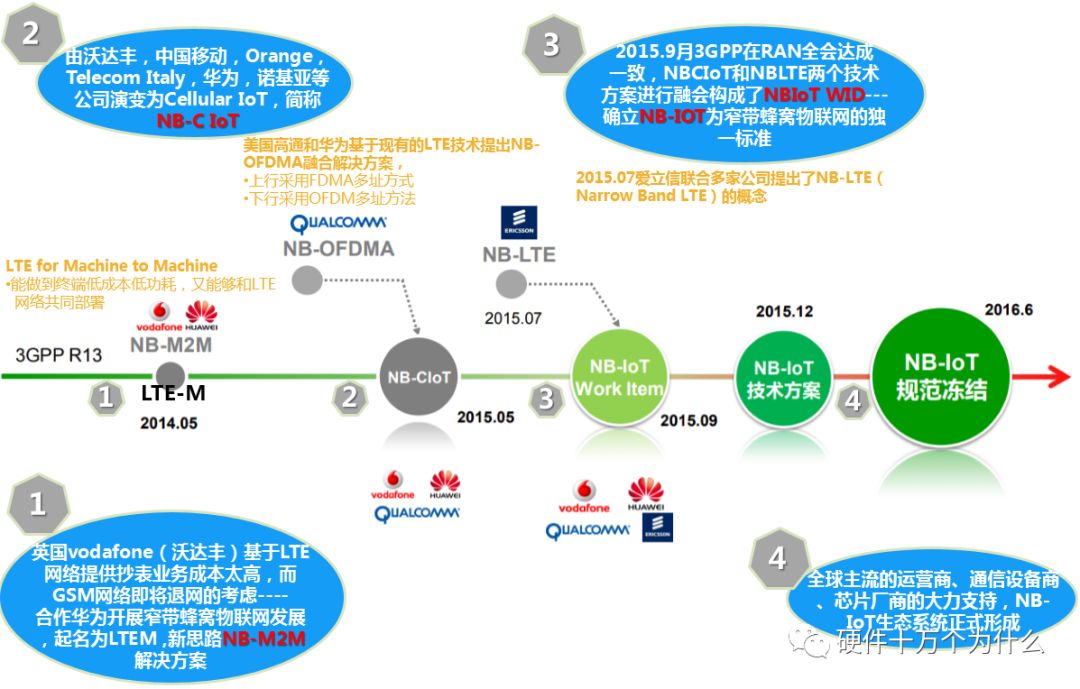
Characteristics of NB-IoT
NB-IoT has the following four main characteristics:
1. Wide Coverage. Compared to existing networks like GSM, broadband LTE, etc., its coverage is enhanced by 20dB, allowing signal transmission to reach areas that GSM networks currently cannot cover (in ideal conditions, GSM base stations can cover 35km). This is primarily achieved by: 1. Reducing bandwidth to enhance power spectral density; 2. Repeating transmissions to gain time diversity.
2. Large Connections. Compared to existing wireless technologies, the number of connections under the same base station has increased by 50-100 times, with each cell capable of achieving 50K connections, truly enabling the massive connections required for the Internet of Everything. This is achieved by: 1. Based on the delay-insensitive characteristics, using traffic models to preserve more context of connected devices, switching between sleep and active states; 2. Narrowband IoT’s uplink scheduling has smaller granularity, leading to higher resource utilization; 3. Reducing signaling interactions in the air interface, enhancing spectrum density.
3. Low Power Consumption. Terminals remain in sleep mode 99% of the time and integrate various power-saving technologies, allowing standby times of up to 10 years. 1. PSM low-power mode, which increases the PSM state in idle mode, effectively shutting down and controlled by a timer for awakening, consuming less energy; 2. eDRX extended discontinuous reception power-saving mode, which employs longer paging cycles, with eDRX consuming 1/16 of the energy of DRX.
4. Low Cost. Hardware can be trimmed, and software simplified as needed, ensuring low costs for NB-IoT; the cost of a single NB-IoT communication module is less than $5.
Due to its applicable scenarios, NB-IoT also features low speed and low mobility. 1. Low Speed. The multi-point uplink speed is only 56kbps, with an ideal downlink speed of 21.25kbps; 2. Low Mobility. It only supports terminal devices to switch cells at a moving speed of 30km/h, far below the 4G support of 250km/h (high-speed rail private networks can reach 450km/h).
Overall Architecture of the NB-IoT Solution
The following diagram shows the overall architecture of the NB-IoT solution:
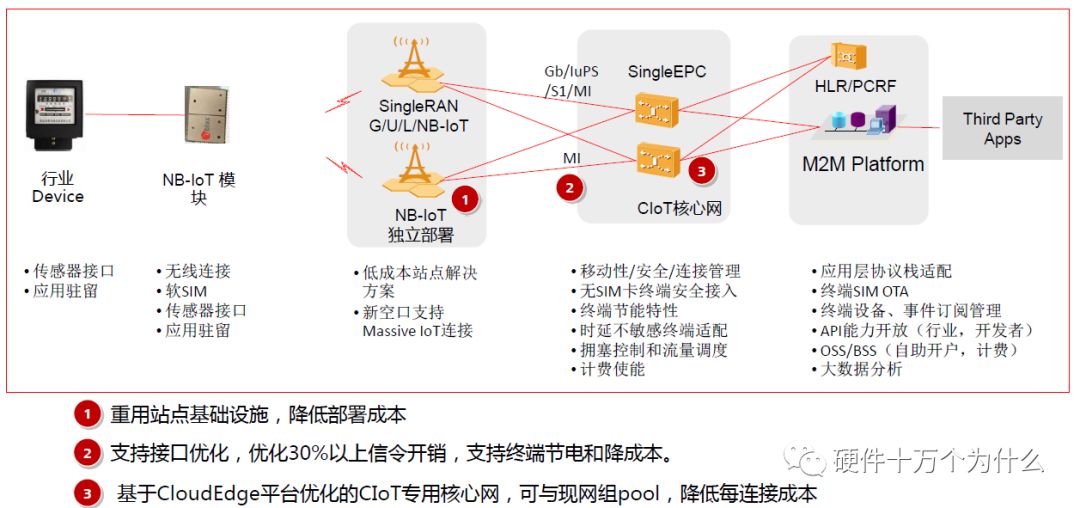
Current Status of NB-IoT Development
The following diagram shows the overview of the NB-IoT ecosystem:
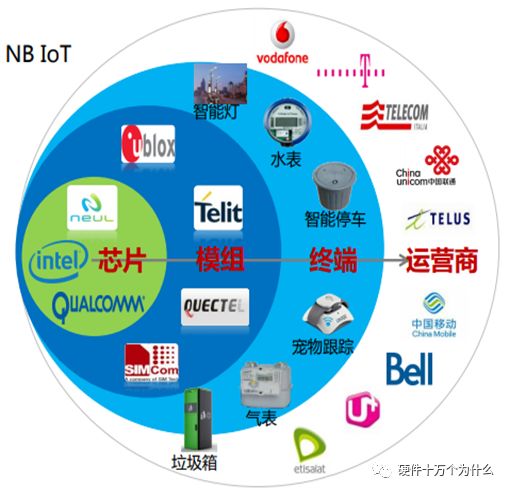
Examples of current trial commercial use and commercial applications of NB-IoT:
1. Huawei/China Unicom’s NB-IoT smart parking solution: This smart parking system based on Huawei’s NB-IoT module will allow functions such as booking and re-leasing parking spaces, with low power consumption and high penetration capability making this solution more reliable. Currently, this parking system is in trial commercial use at Shanghai Disneyland.
2. On July 13, 2017, ofo shared bicycles announced the full commercial launch of the NB-IoT “smart lock” co-developed with China Telecom and Huawei.
3. ZTE/China Mobile’s smart manhole cover: This solution can provide timely warnings when the manhole cover is opened or displaced, through comprehensive monitoring of the manhole cover status.
In terms of NB-IoT chip development:
1. Huawei, as the largest NB-IoT chip manufacturer in China, has launched the Boudica 120/Hi2110 IoT chip, featuring Huawei LiteOS embedded IoT operating system.
2. Qualcomm has launched the MDM9206 IoT chip, supporting Cat-M1 and Cat-NB1 standards across all global frequency bands, with multi-mode support for GSM/NB-IoT/eMTC, and also supporting GPS and global navigation satellite positioning.
3. ZTE Microelectronics has developed the RoseFinch 7100 (also known as “Zhuque”) NB-IoT chip, designed for low-power IoT applications, leading the industry in core indicators related to sleep power consumption, cutoff voltage, and the number of peripheral interfaces.
4. Intel has launched the XMM 7X15 series IoT chips.

IC Job Hunter’s Guide: 2018 IC Design Company Written Test Question Analysis – Nvidia
IC Job Hunter’s Guide: 2018 IC Design Company Written Test Question Analysis – Cambricon (Verification Direction)
IC Job Hunter’s Guide: 2018 IC Design Company Written Test Question Analysis – Goodix
IC Job Hunter’s Guide: 2018 IC Design Company Written Test Question Analysis – Cadence
IC Job Hunter’s Guide: 2018 IC Design Company Written Test Question Analysis – Horizon
Benefits
Reply with the keyword “Get Materials” to obtain the IC material package
